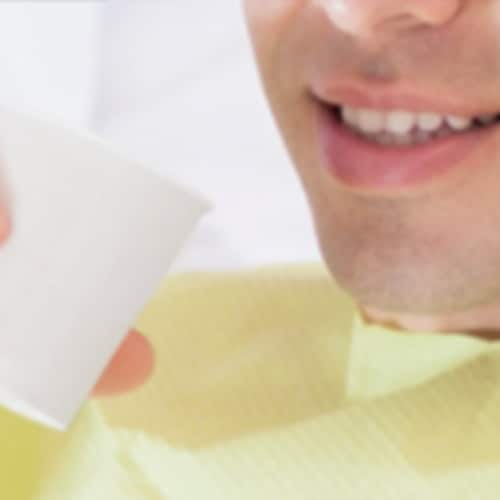SARS-CoV-2, the pathogen that causes COVID-19, is transmitted largely by airborne transmission via aerosols, to a lesser extent by droplets, and to a much smaller extent by contact with contaminated surfaces and objects (fomites). For this reason, the dental operatory is a particularly high-risk environment for viral transmission.
As a dental student, you will have observed and participated in a number of evidence-based precautions aimed at minimizing transmission risk. These include but are not limited to triaging patients, limiting the use of aerosol-generating procedures, using additional required and recommended PPE, following enhanced infection control protocols, and leaving more time between patient treatments. If you didn’t already, you may have also begun to use pre-procedural rinsing for every patient.
New research on pre-procedural rinsing and viral load
While evidence exists for the efficacy of pre-procedural rinsing in reducing bacterial loads, there has so far been limited research supporting the efficacy of pre-procedural rinsing in reducing viral loads. A recent pilot study published in June 2021 investigated the effect of several mouth rinses in reducing the salivary viral load of SARS-CoV-2.
As discussed by the authors of the pilot study, SARS-CoV-2 has been detected in the saliva, gingival crevicular fluid, oral mucosal cells and salivary glands of infected individuals. With the evidence suggesting that the oral cavity acts as a reservoir for SARS-CoV-2, the authors investigated the extent to which pre-procedural rinsing could lower the salivary viral load.
About the study
The pilot study was a randomized, double-blind, single-center clinical trial involving hospitalized patients with COVID-19. There were five randomly assigned groups in total, each using one of the following mouth rinses:
- Distilled water (placebo).
- A 0.075% cetylpyridinium chloride and 0.28% zinc lactate solution (CPC + Zn).
- A 1.5% hydrogen peroxide solution (HP).
- A 0.12% chlorhexidine gluconate solution (CHX).
- A 1.5% hydrogen peroxide solution followed immediately by a 0.12% chlorhexidine solution (HP + CHX).
Saliva samples were taken from each patient before, immediately after, 30 minutes after, and 60 minutes after rinsing, and SARS-CoV-2 viral loads were measured.
Findings
Immediately after rinsing, the largest reductions in viral load compared to baseline were produced by the CPC + Zn rinse with a more than 20-fold reduction and the HP rinse with a more than 15-fold reduction, higher than for CHX (2.1-fold). At 30 minutes after rinsing, both groups still displayed a significant reduction. At 60 minutes, the CPC + Zn group had maintained a modest reduction of 2.6-fold, while the HP group had returned almost to baseline levels.
The CHX rinse produced a relatively modest -- but significant -- reduction immediately after rinsing, with a more than 2-fold reduction in viral load compared to baseline. However, unlike the CPC + Zn and HP rinses, the reduction increased after 30 minutes, with a 6.2-fold reduction compared to baseline. At 60 minutes, the CHX rinse had maintained a 4.2-fold reduction, higher than that of the CPC + Zn rinse which provided for a 2.6-fold reduction at the same time point.
For sequential rinsing with HP + CHX, there was no significant difference in the viral load reduction compared to the CHX group immediately after rinsing. Given that HP alone had achieved a much larger reduction at this same point, it is thought that the subsequent use of CHX may have rinsed the HP from the oral cavity before it could result in any measurable change. At 30 and 60 minutes, sequential rinsing resulted in a lesser reduction than rinsing with CHX alone.
What does this mean for dental students?
In the absence of evidence specific to SARS-CoV-2, dental students and professionals have so far used pre-procedural rinsing as a precautionary measure based on what we know about these agents and their interactions with other pathogens.
CHX and CPC + Zn are anti-microbial agents that have been shown to reduce intra-oral bacterial loads, and CHX was found to reduce the intra-oral viral load of other viral pathogens in a previous study. HP is an oxidative agent that degrades the protective, lipid-containing “shell’ of enveloped viruses (which includes SARS-CoV-2).
The findings of this pilot study demonstrate the effect of these rinses in direct relation to SARS-CoV-2. The research shows that, although the effect is transient, we can in fact achieve a significant, measurable reduction in the salivary viral load with pre-procedural rinsing.
We must also acknowledge the limitations of this pilot study, such as its small sample size and the absence of data regarding baseline oral health status. However, as dental students and professionals work harder than ever to provide safe treatment, we welcome this research in support of a simple method to manage salivary viral loads.


Was this article helpful?
If you’d like a response, Contact Us.